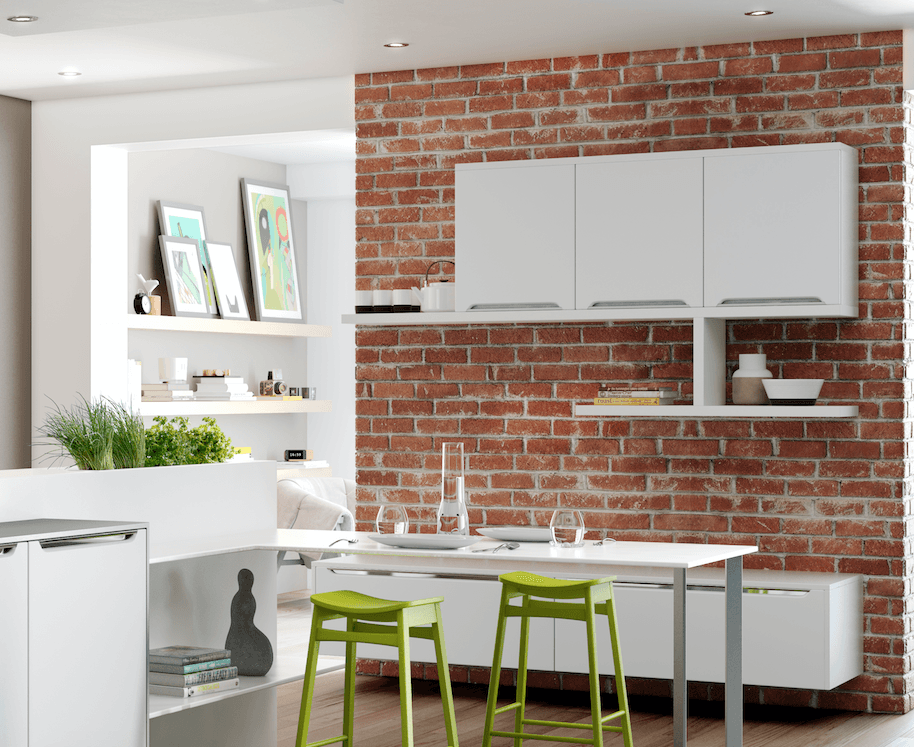Kitchen Planning
Room for dessert
02.01.2019


With expert design, you can create a space that meets all of your culinary needs even when space is limited. Here are our top tips for maximising functionality and comfort in smaller kitchen plans.
Before you begin looking at catalogues, consider how you use your current kitchen and plan how space will be used in your new kitchen. When it comes to small design plans, any ‘excess’ items can be removed to free up space for the features you don’t want to ‘sacrifice’ just yet. Once you’ve separated the essentials from the extras, you can begin to optimise the way that your kitchen space is used.
Our first piece of advice is to make use of hidden storage and multi-purpose items:
Double up with furniture. Specially designed stools, for example, can double up as coffee tables. A bespoke table can even ‘triple up’ as your dining table, kitchen worktop and a wine rack! And smart furniture like this is even more adaptable when it can move. Midas Kitchens recently worked on a project that used moveable islands and units to build efficient and adjustable kitchen spaces. These units can be moved to the area in which they’re needed, when they’re needed and moved out of the way when they’re not.
Furniture such as your dining table and ironing board don’t need to be out all of the time so foldaway furniture is also a brilliant space saver. With inventive furniture you can prep and cook in an area that’s big enough to navigate easily but still sit down and enjoy your meal at a proper table afterwards. We love the swing out island mounted bar stools showcased in this post by apartment therapy.
Custom-designed units can house your kitchen must-haves in a way that uses every inch of kitchen space. If there’s a sliver of space between the fridge and a wall, consider asking for a hidden rolling pantry. These are perfect for storing items such as canned goods in a space that was once inaccessible and redundant. Seating stations and cupboard doors can have built-in storage units.
Remember to make use of your walls too. Open shelving is brilliant for utilising wall space and if you choose your kitchen accessories well, your kitchen essentials can become an attractive feature wall. Or if there’s a blank space at the end of a worktop unit, install a bespoke plate rack or spice rack, and free up room elsewhere.
Floor planning is a really important element of small kitchen design. Efficient layouts for small kitchens include galley or corridor, L-shaped and a single wall of cabinets. The galley and L-shaped plans are good because they facilitate the ‘kitchen triangle’ movement. One wall of counters means a lot of back and forth but this is a good layout when space is really limited. A U-shaped kitchen with three lines of worktops is best avoided because floor space is significantly reduced. Adding an island to the L-shaped layout is not ideal for the same reasons.
Many ranges offer smaller appliances designed specifically for small kitchens such as slimline dishwashers. With enough space to wash up after two people for a couple of days – unless you have a large family to feed – these are perfect for couples or young professionals who eat out a lot. Even downsizing on the size of your kitchen sink can make room for other kitchen essentials that you really do need.
When it comes to choosing appliances for your small kitchen, less is more. Think about how you use your appliances at the moment: how regularly do you you use them and are there any features that you don’t ever use? If the answer’s yes, downsize your appliances. You’ll maximise space and increase how efficiently you use them. Of course we would all love the biggest fridge or a jumbo dishwasher but if you don’t need them, prioritise and make additional space elsewhere. Choose the right sized appliances – if you don’t need to whip up a Sunday roast for six, opt for a smaller oven.
Once you’ve got all the practical features sorted, it’s time to think about the kind of space your kitchen is going to be. The great news is there are plenty of foolproof ways to make a small space look and feel bigger, improving the comfort and ‘feng shui’ of your kitchen.
Firstly, using light colours on both the walls and floors immediately makes a room feel more airy and spacious. While darker colours make a room seem cosy, they also absorb light instead of reflecting it, making the space feel smaller. If you opt for colour as opposed to neutrals, pair different shades of the same colour to create unity. And leave your windows uncovered to allow more light in and give the room more depth.
When it comes to decorative items, these aren’t usually a priority unless working with a large kitchen space. But even with a smaller kitchen, don’t necessarily rule them out completely. Smaller decorative accents crowd a room so opt for fewer decorations that are are bigger. Then, glass and lucite pieces can provide a function while not taking up too much visual space.
Anything that makes a group of smaller items look intentionally placed will make it appear more streamlined. So whether it’s with size, colour or type, arrange your items deliberately. Colour coding your shelves for example can create a look of structure.
Pushing furniture up against the walls can make everything look and feel cramped. Even just a few inches in between the wall and your seating areas and counters can make the space look more open. Then to make use of those few inches, you can order a custom made foldaway table or bar to slip behind it! Similarly, hang shelves near the ceiling to draw the eye upward.
For ideas on how to use the corners of your kitchen, read our blog post on kitchen corner ideas.